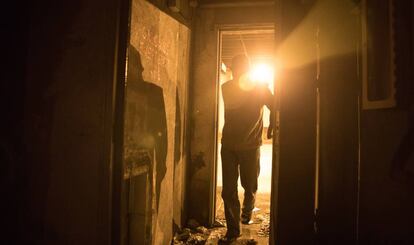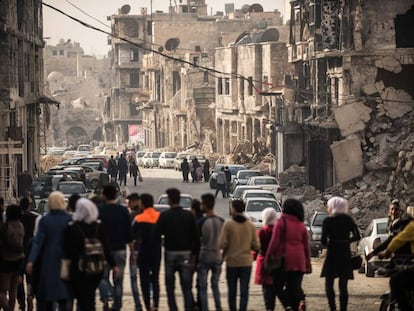From the bombs in Aleppo to a leaky tunnel in Madrid
An increasing number of homeless people are spending their nights in an underground maze in AZCA, the city’s financial district

Omar has gotten used to living in hiding. His life is consumed in the shadows, just like the candle that he lights every night in an emergency exit located inside a network of tunnels under the cluster of residential buildings, office space and department stores known as AZCA, Madrid’s financial district.
First it was the bombs in Syria, the country where he was born 67 years ago. For the last six years he has been living in this subterranean traffic space because he has nowhere else to go. He has no papers. “I am nobody,” he says in a clean Spanish that he has learned “on the few days” that he goes out above ground.
The people who go to the shelters are rotten: they don’t wash, they smell bad and they’re drunk
Omar, homeless man
Like him, around 20 homeless people have settled down inside this underpass where three lanes have been closed off to traffic since January because of the leaks in the walls.
A bricklayer by trade, Omar has a strong build and stands nearly two meters tall. He lost his wife and two children under the bombs in Aleppo, but refuses to talk about it. “I have been dead since then.”
He fled the war and ended up in Madrid via Italy, then eventually settled down in this downtown tunnel, far from the gaze of the pedestrians above him and the vehicles that drive by on the open lanes nearby.

This emergency exit has been Omar’s home since November. Other tunnel dwellers are staying in the closed tunnels and in areas that look like emergency parking spots. The closed tunnels are the right-hand lanes of the exits leading out to Basílica, Agustín de Betancourt and Capitán Haya streets.
While city authorities debate what to do about the leaks, Omar shields himself from the cold with a collection of blankets. The leaks are not so bad here, and he shares this space with five Spaniards. The last two arrived here on February 28, and they are still not back even though it is past midnight and it is raining outside.
2,059 people without homes
A Madrid city spokeswoman said that this spot “does not constitute a stable population center.” Tunnel maintenance workers confirm that the number of dwellers fluctuates.
There are 2,059 homeless people in the Spanish capital, according to the last count made by city officials in December 2016. Of these, most (1,121) were sleeping at shelters, while 414 were staying at apartments and the rest spent nights out of doors. Or in a tunnel.
Mattresses and blankets are strewn across the parking area. The improvised beds are still empty, surrounded by piles of trash.
“Most of the people who live here are drug addicts. They relieve themselves inside the tunnel, and we have to jump over feces, urine and occasionally also needles,” notes a maintenance worker.
This city employee says that they are generally not dangerous people, but that on one occasion they used knives to threaten workers. “The municipal sanitation service showed up and took their things away. They thought it was us,” he notes.
A couple who lives in one of the emergency exits warned this reporter that they had no desire to talk about their experience, and threaten anyone who would dare disturb them.
Omar lost his wife and two children under the bombs in Aleppo
Omar, who would not reveal his surname, lives just a few meters down from them. “I am nobody,” he repeats. Some red panels reveal his exact location: 07 T-Azc 560. A metal door is blocked by a pile of bags, food leftovers, excrement and empty alcohol bottles.
A man wakes up, flips open a lighter and agrees to talk on condition that no pictures will be taken. He gets up, slips into dirty-looking flip-flops and notes that he has not applied for any form of city welfare.
“Nobody does anything for anybody, not even for other Spaniards living here,” he says. A few tunnel residents receive food from local charity groups in the Tetuán district, and take showers at Asociación Bokatas, a group that works directly with the homeless.
A city spokeswoman said that workers for Samur Social, the municipal social assistance services, occasionally drop by the tunnels to offer people resources and the chance to go to a shelter. “I don’t want to go,” says Omar. “The people who go there are rotten: they don’t wash, they smell bad and they’re drunk.”
“There are around 20 of us in the tunnel now, but there are some really dangerous people: thieves, drug addicts and rapists. The police comes from time to time to arrest them,” he adds.
A spokesman for the municipal police said that most of the times they go to the tunnels, it is because a local resident phoned in to complain. “They occupy the exits and that could pose a risk, so they get kicked out.”
But they return just a few days later. Or sometimes a few hours later. Mercedes González, a city councilor for the Socialist Party, says it is “unacceptable for people to be living inside the tunnels permanently, when we’re supposed to have the financial city above them. It’s intolerable. It is a sign of the lack of oversight by the concession holder and by city government.”
English version by Susana Urra.
Tu suscripción se está usando en otro dispositivo
¿Quieres añadir otro usuario a tu suscripción?
Si continúas leyendo en este dispositivo, no se podrá leer en el otro.
FlechaTu suscripción se está usando en otro dispositivo y solo puedes acceder a EL PAÍS desde un dispositivo a la vez.
Si quieres compartir tu cuenta, cambia tu suscripción a la modalidad Premium, así podrás añadir otro usuario. Cada uno accederá con su propia cuenta de email, lo que os permitirá personalizar vuestra experiencia en EL PAÍS.
¿Tienes una suscripción de empresa? Accede aquí para contratar más cuentas.
En el caso de no saber quién está usando tu cuenta, te recomendamos cambiar tu contraseña aquí.
Si decides continuar compartiendo tu cuenta, este mensaje se mostrará en tu dispositivo y en el de la otra persona que está usando tu cuenta de forma indefinida, afectando a tu experiencia de lectura. Puedes consultar aquí los términos y condiciones de la suscripción digital.










































